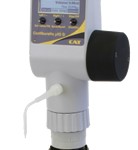Bottle-Top Burette Purchasing Decisions
What to Look for in a Bottle-Top Burette
Burettes and their close cousin pipettes are used for precision metering and dispensing reagents into a solution, usually as part of performing a chemical analysis. Burets are glass tubes with capacity markings in milliliters. They have a valve at the bottom that is used by researchers to dispense a specific amount of reagent into a receiving vessel. Pipettes dispense their entire volume.
Fragile, difficult to clean, and subject to human measuring error, glass tube burettes and pipettes often are replaced by bottle top burettes such as the Contiburette models available from CAT Scientific. These types of burets are either manually driven or motor driven, which we’ll explore shortly.
A large portion of value in bottletop burets stems from their efficiency when it comes to repetitive precision metering and dispensing a single reagent. This is because, unlike glass tubes, they do not have to be repeatedly cleaned and/or refilled for each experiment. But this does not discount their ease in cleanability when changing reagents.
In this post we will take a look at some (but not all) points to look for when comparing bottletop burettes available from different manufacturers. Certain of these points are explored in more detail elsewhere on our website.
Dispensing Accuracy: Bottletop burettes are designed to conform to ASTM E287-02 (2007) “Standard Specification for Laboratory Glass Graduated Burets.” Class A is defined as precision-grade burets, and since you asked, Class B is general purpose. Because glass burets have no moving parts save the hand-operated and permanently attached stopcock their long-term accuracy is not subject to question. On the other hand, the accuracy of the operator may be subject to question.
 Bottletop burettes, whether hand or motor driven, are designed to conform to Class A criteria as well but, and it is a BIG but, the question is how long is this accuracy maintained. Moving parts can wear and dispensing valves can result in what is called dead volume. This is why manufacturers and regulatory agencies require that bottle top burettes are periodically calibrated. We’ll touch a bit more on calibration later.
Bottletop burettes, whether hand or motor driven, are designed to conform to Class A criteria as well but, and it is a BIG but, the question is how long is this accuracy maintained. Moving parts can wear and dispensing valves can result in what is called dead volume. This is why manufacturers and regulatory agencies require that bottle top burettes are periodically calibrated. We’ll touch a bit more on calibration later.
Materials of Construction
Some reagents can be pretty nasty, attacking pumps and metering components in bottletop burettes unless these components are fabricated of highly corrosion-resistant materials. For example, all wetted parts in CAT Contiburettes are made of aluminum oxide (Al2O3) and transparent polymer Ethylene tetrafluoroethylene (ETFE). Both of these are noted for their excellent chemical resistance to virtually all liquids used in the lab. Contiburette system electronics are completely isolated from the solution being dispensed. There are no valves in the dispensing mechanism, which assures minimum dead volume.
Hand or Motor Driven
This is a rather simple decision. While both options dispense or meter to Class A accuracy, hand-operated burettes are less costly. If you continually perform dispensing or metering such as in a computer-driven automated system using the same reagent you’ll save operator time with a motorized burette. Otherwise select a hand-operated model. In the former, Contiburettes are powered by a 9-volt DC adaptor; in the latter data are controlled and displayed by two AA batteries.
Cleanability
Cleaning and otherwise preparing glass tube burettes and pipettes is exacting and time consuming. Not so with bottletop burettes. While Contiburette procedures are spelled out in the user manual, here’s a condensed version:
- Thoroughly drain the reagent retained in the metering system into a suitable receptacle.
- Affix the mechanism to a bottle containing a rinsing solution, nominally but not necessarily distilled or DI water. (A sanitizing alcohol rinse is recommended if disinfecting is required.)
- Operate the burette to totally flush out the reagent residue into a suitable receptacle.
- You’re ready for the next project.
Certain models in the Contiburette line have an integrated rinsing system that recirculates the rinsing solution from an on-board container.
Calibration
As suggested above, calibration is an exercise taken periodically (and as spelled out in your company’s operating manual) to confirm the metering and dispensing accuracy of a bottletop burette. All Contiburette models have a calibration function, the instructions for which are in the user manual. A more comprehensive description of a calibration exercise is posted elsewhere on this site. This is because the nature of the exercise depends to a great extent on the chemical properties of the reagent in question.
GLP/ISO Record Keeping
Paper trails are essential to conform to GLP, ISO and other regulations. Contiburette motor-driven burettes are equipped with an RS 485 interface that enables connectivity to printers and PCs. Manual data entry is required for hand-operated burettes.
In Summary
We hope you find this information useful as you contemplate the purchase of a bottletop burette. Please check the Contiburette specs on this site as well as other posts relating to the topic.
For more detailed information on bottletop burettes and other lab equipment for liquid handling ask us a question or contact the experts at CAT Scientific.
